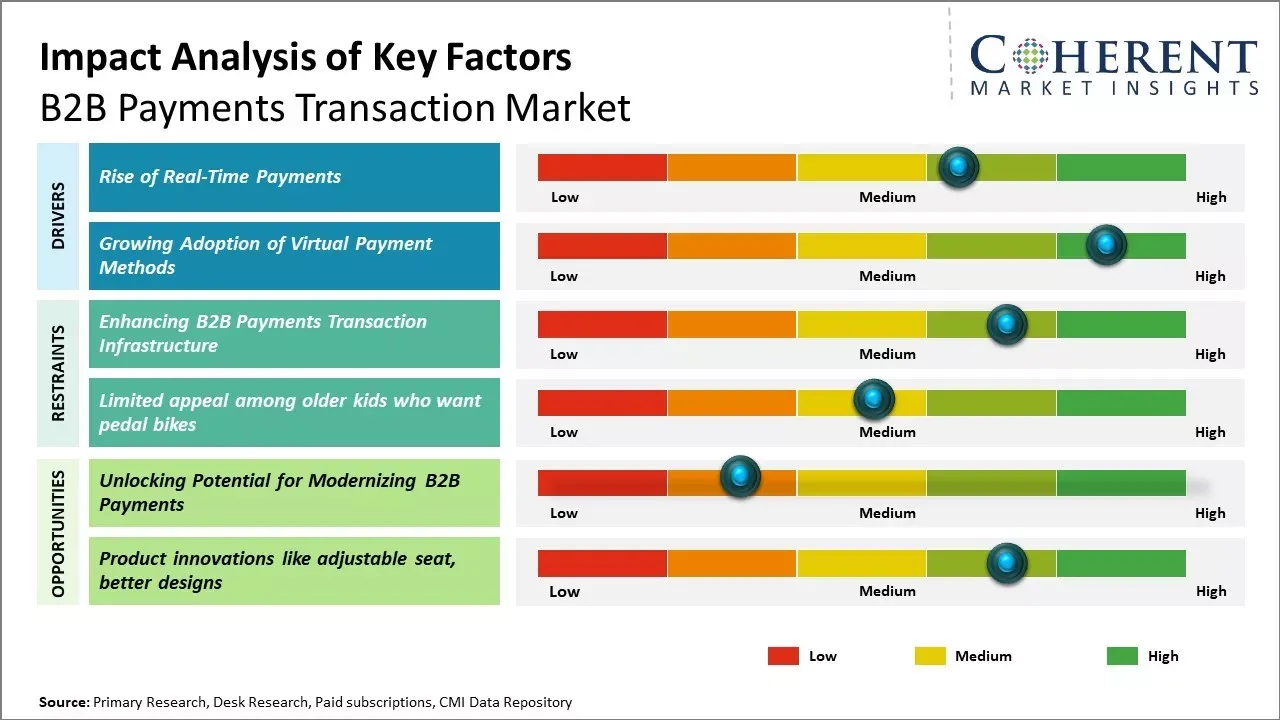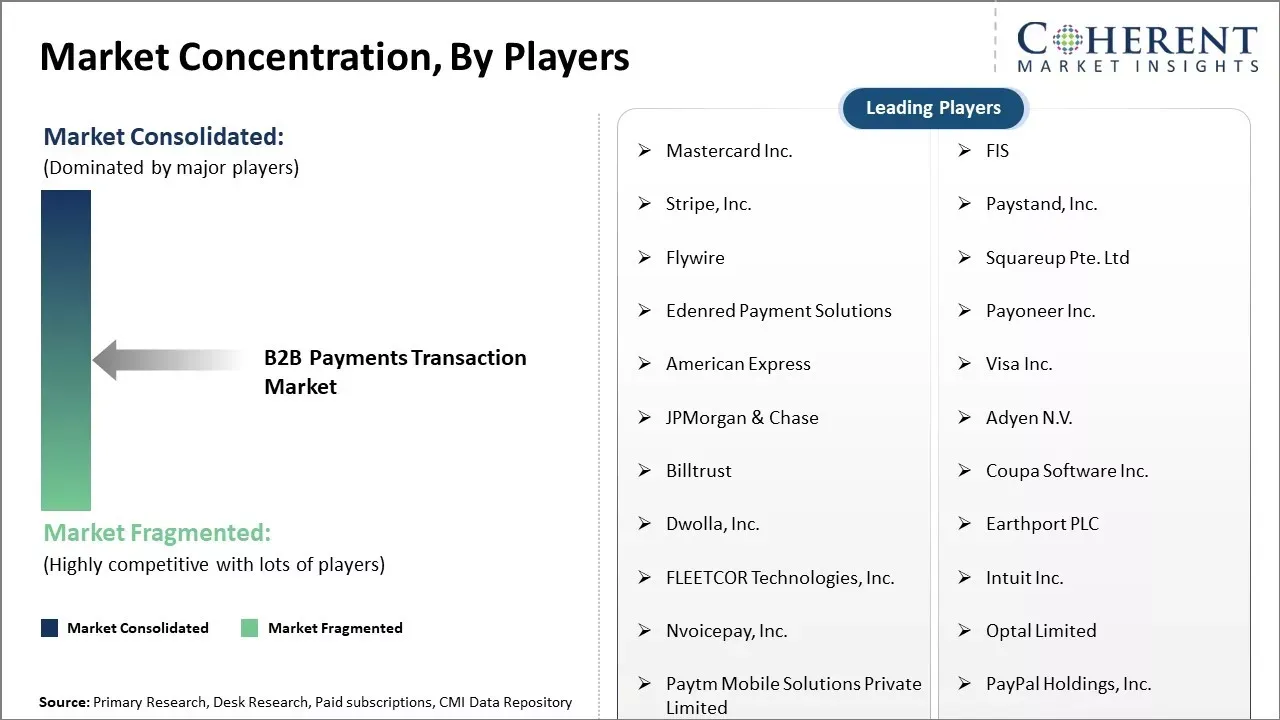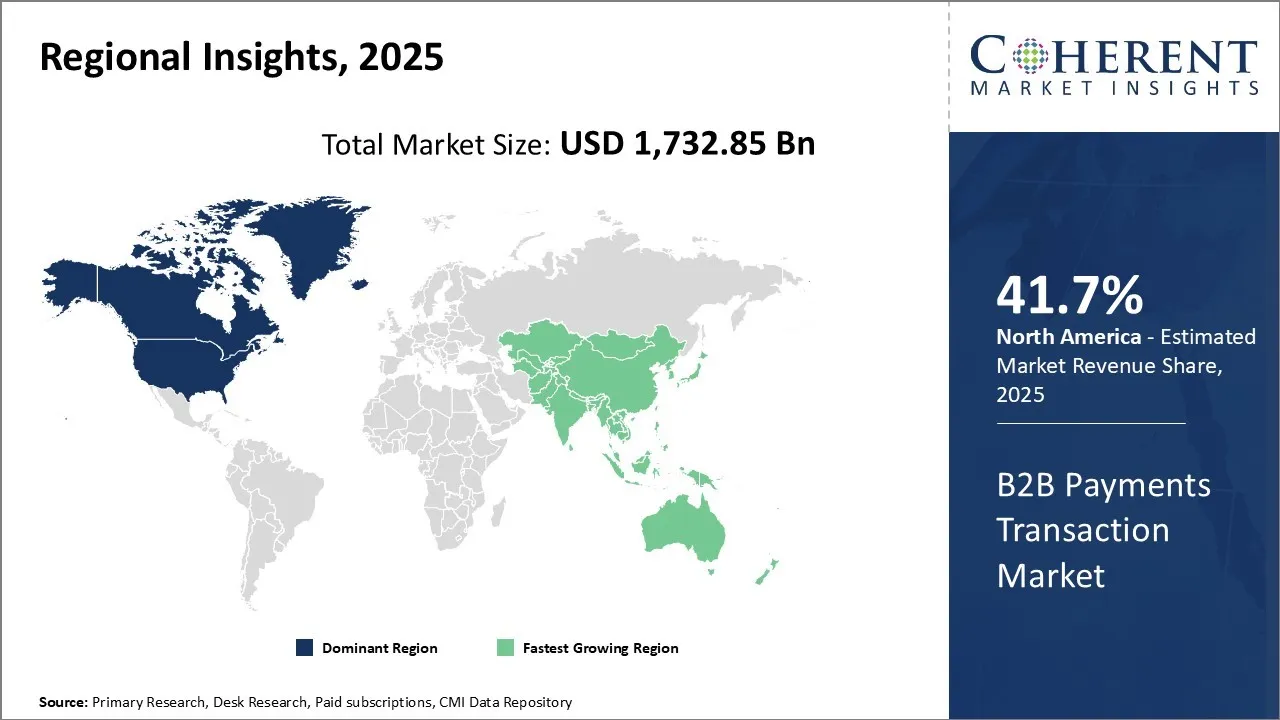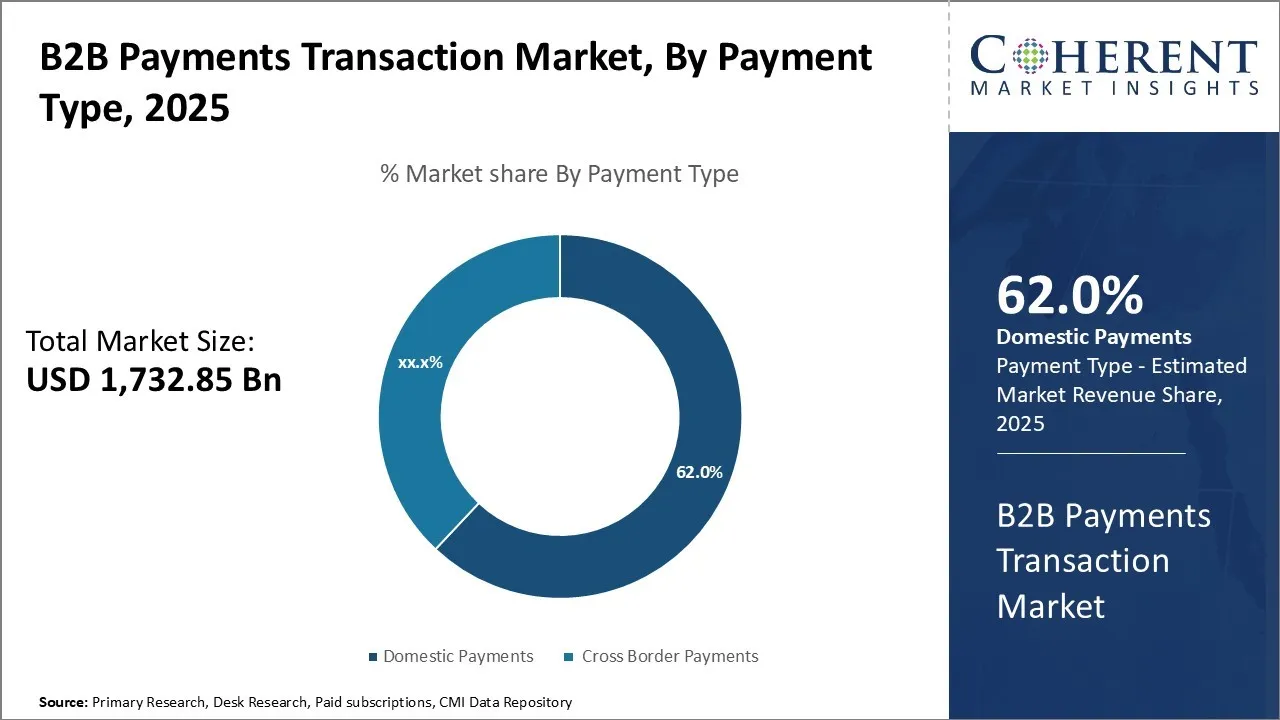B2B Payments Transaction Market Size and Trends - 2025 to 2032
The B2B payments transaction market is estimated to be valued at USD 1,732.85 Bn in 2025 and is expected to reach USD 3,357.55 Bn by 2032, growing at a compound annual growth rate (CAGR) of 9.9% from 2025 to 2032.
Key Takeaways
- Based on Payment Type, the Domestic Payments segment is expected to lead the market with 62% share in 2025, due to familiar markets and established banking infrastructure.
- Based on Payment Method, the Bank Transfer segment is expected to hold 48.4% share of the market in 2025, driven by online banking and ACH automation that simplify and digitize B2B payments.
- Based on Enterprise Type, the Large Enterprises segment is projected to account for 65.8% share in 2025, leveraging optimized payment platforms to manage complex supply chains and thousands of vendor relationships efficiently.
- Based on Industry, the Manufacturing segment is projected to capture the largest share of the market in 2025, due to high-value transactions, extensive suppliers, and continuous global supply chain payments.
- Based on Region, North America is set to lead the B2B payments transaction market with 41.7% share in 2025. While, Asia Pacific is anticipated to be the fastest growing region.

To learn more about this report, Download Free Sample
Market Overview
This sector encompasses payments made between businesses, as well as between businesses and suppliers. The growing digitization of B2B commerce and increasing adoption of digital payment methods are driving the transaction value in this marketplace.
The B2B payments transaction market is trending towards the greater digitalization and automation of business spending. Corporations are embracing tech-enabled B2B payment solutions that integrate with their Enterprise resource planning (ERP)/accounting systems for enhanced reporting and reconciliation capabilities. Digital payment rails are also growing in popularity over paper-based methods like checks, as they offer improved security, speed, and insight into organizational spending habits. This digital shift will continue propelling transaction volumes higher over the forecast period.
Current Events and Its Impacts on the B2B Payments Transaction Market
|
Current Event |
Description and the Impact |
|
Central Bank Digital Currency (CBDC) Development and Implementation |
|
|
Rising Global Interest Rates and Inflation Pressures |
|
Uncover macros and micros vetted on 75+ parameters: Get instant access to report
Role Of Artificial Intelligence (AI) In B2B Payments Transaction Market
AI is shifting the B2B payments transaction market by making it possible to automate, use predictive analytics, and find fraud. AI-powered tools make it easier to handle invoices, reconcile them, and get them approved, which cuts down on the need for people to do things by hand and lowers operational costs. Real-time information makes it easier to manage cash flow and make decisions. Businesses can make high-volume B2B payments more efficiently, accurately, and safely by using AI. This is going to enhance supplier relationships and encourage adoption by large and small businesses around the world.
For instance, in October 2025, BILL has added "AI agents" to its system to automate financial tasks, making it possible for businesses to make "touchless B2B payments." The technology speeds up the processing of invoices, the reconciliation of receipts, and the approval of workflows. This reduces down on the amount of work that needs to be done by hand in the back office, speeds up transactions, and improves accuracy. This allows companies make large corporate payments with little human involvement.
Market Concentration and Competitive Landscape

To learn more about this report, Download Free Sample
B2B Payments Transaction Market Insights By, Payment Type: Domestic Familiarity Drives Preference for Domestic Payments
In terms of payment type, domestic payments segment contributes the highest share of 62.0% in 2025 of the market owing to the familiar business environment and relationships that companies have within their home country. Transacting domestically allows businesses to leverage existing banking partnerships and payment rails that require minimal setup costs and streamline approval processes. This preexisting infrastructure established through years of operation makes domestic transactions frictionless compared to setting up arrangements in new foreign markets.
For instance, in November 2024, Zoho has released Zoho Payments, a domestic B2B payments platform that lets Indian businesses handle and pay bills online. It works with Zoho's finance suite and is powered by BBPS. It supports UPI, cards, and net banking, and its goal is to make supplier payments easier and digital transactions faster for businesses in India.
B2B Payments Transaction Market Insights By, Payment Method: Online Enablement Boosts Bank Transfer Usage
In terms of payment method, bank transfer contributes the highest share of 48.4% in 2025 of the market owing to advancements in online banking platforms that have streamlined the process. Where bank wires once required significant manual effort, payment initiation can now be accomplished from any internet-connected device with only a few clicks. Automated clearing house (ACH) networks in many regions have similarly eliminated the paperwork formerly associated with electronic funds transfer (EFT).
For instance, in September 2024, Easebuzz teamed up with NPCI Bharat BillPay Ltd (NBBL) to start a B2B payments service that lets businesses automate invoice management and pay their bills using bank-linked methods like net banking, NEFT, UPI, cards, and wallets. The platform makes it easier to pay suppliers and speeds up digital B2B transactions in India.
B2B Payments Transaction Market Insights By, Enterprise Type: Operational Scale Drives Priority for Large Enterprises
In terms of enterprise type, large enterprises contribute the highest share of 65.8% in 2025 of the market owing to economies of scale that make optimized payment platforms a high priority. Complex supply chains and thousands of vendor relationships require coordination impossible with outdated manual methods. Large fixed costs are justifiable to consolidate partnerships onto platforms streamlining approval workflows, payments, and remittance between divisions and suppliers.
For instance, in July 2025, Two company raised €13 million to grow its B2B payments platform, which allows businesses offer quick payments and flexible net-term options. The funds it will receive will help it grow its infrastructure to support both large businesses and small and medium-sized businesses (SMEs). This will help it grow globally and improve its ability to handle digital B2B transactions in many different industries.
B2B Payments Transaction Market Insights, By Industry Vertical: Manufacturing Leads as Its Complex Supply Chains Require Frequent, High-Value Transactions Across Extensive Global Vendor Networks
In terms of industry vertical, the manufacturing segment is expected to lead the market with largest share in 2025, due to it has numerous of suppliers, buys a large number of goods, and makes a lot of high-value transactions. Manufacturing is the industry that contributes the most to overall B2B transaction value since it has a lot of payment flows due to things like constant sourcing of raw materials, coordination of the global supply chain, and regular payments to vendors.
For instance, in July 2025, Oro released OroPay, a payment system that works with its B2B ecommerce platform, OroCommerce. It is aimed at manufacturers and distributors. The solution makes it easy for businesses in the manufacturing and distribution sectors to send and receive digital invoices and make B2B payments. This speeds up transactions, makes it easier to manage cash flow, and makes operations more efficient.
Regional Insights

To learn more about this report, Download Free Sample
North America B2B Payments Transaction Market Analysis & Trends
North America has remained the dominant region with 41.7% in2024 of the global B2B payments transaction market over the past decade. The region boasts a strong presence of payment processors and financial technology companies that offer various payment solutions catered towards businesses. The digital payment infrastructure and acceptance rates are highly developed here, allowing for seamless B2B transactions both domestically and cross-border. In addition, supportive regulations by governing bodies have helped create a conducive environment for electronic B2B payments to thrive. Industrial sectors like manufacturing, retail, healthcare that involve significant B2B activity are well established in the region. This has sustainably driven the utility of digital B2B payments for procurement, payables, receivables and others on a large scale.
For instance, in September 2025, Alternative Payments has grown into Canada, where it has improved its B2B payment services by giving businesses digitized, automated payment workflows. The platform works with bank rails to make business transactions easier and faster, allowing for faster and more efficient B2B payments across North America. It also helps businesses manage both domestic and cross-border payment processes.
Asia Pacific B2B Payments Transaction Market Analysis & Trends
The Asia Pacific region has emerged as the fastest growing market for B2B payments globally in recent years. Rapid digitalization of businesses combined with rising internet and smartphone penetration have accelerated the shift from traditional to electronic B2B payment methods. Cross-border B2B transactions between Asia Pacific countries as well as with North America and Europe are increasing at a breakneck pace. This is strengthening the business case for payment solutions tailored to B2B commerce. Several global payment providers have augmented their presence in developing markets within Asia Pacific to tap rising demand from SME and large enterprise segments. Regional players are also introducing new age payment products to gain ground in the energetic commercial landscape of Asia Pacific. The confluence of economic growth, regional trading and digital transformation continue to propel the B2B payments transaction market in Asia Pacific ahead of other regions.
For instance, in November 2025, OxPay obtained a license in Bhutan to offer crypto-powered B2B payment services, which let businesses use stablecoins to make payments across borders. The platform speeds up, secures, and digitizes business transactions by combining cryptocurrency technology with traditional B2B payment workflows. This makes it easier for companies to send money across borders and pay their bills.
B2B Payments Transaction Market Outlook Country-Wise
The U.S. B2B Payments Transaction Market Trends
In 2025, the B2B payments market in the U.S. is expected to be strong as many businesses and small businesses use digital and smart payment systems, there is a large corporate and small business ecosystem, the banking system is advanced, and there is a high demand for fast, safe, and efficient cross-border and domestic business transactions in many industries.
For instance, in December 2025, N3XT launched the first fully blockchain-powered bank for instant, programmable B2B payments, allowing U.S. businesses to use smart contracts to make and settle transactions in U.S. dollars 24/7. The platform speeds up, makes payments more open, and automates them for businesses, starting with the US market.
China B2B Payments Transaction Market Trends
In 2025, the B2B payments market in China is booming owing to rapid digitalization, the growth of e-commerce and manufacturing, government programs that encourage cashless transactions, and the widespread use of fintech solutions. Businesses are using automated, safe, and efficient B2B payment systems more and more to handle a lot of transactions, both within the country and across borders.
For instance, in December 2025, TenPay Global and Mastercard teamed up to create a new remittance service for the Asia-Pacific region. This service makes it easy and safe to send funds from China to markets around the world. The platform is mainly for personal remittances, but it also supports digital B2B payment flows, which makes business transactions in the region and around the world more efficient and reliable.
Market Report Scope
B2B Payments Transaction Market Report Coverage
| Report Coverage | Details | ||
|---|---|---|---|
| Base Year: | 2024 | Market Size in 2025: | USD 1,732.85 Bn |
| Historical Data for: | 2020 To 2024 | Forecast Period: | 2025 To 2032 |
| Forecast Period 2025 to 2032 CAGR: | 9.9% | 2032 Value Projection: | USD 3,357.55 Bn |
| Geographies covered: |
|
||
| Segments covered: |
|
||
| Companies covered: |
Mastercard Inc., FIS, Stripe, Inc., Paystand, Inc., Flywire, Squareup Pte. Ltd, Edenred Payment Solutions, Payoneer Inc., American Express, Visa Inc., JPMorgan & Chase, Adyen N.V., Billtrust, Coupa Software Inc., Dwolla, Inc., Earthport PLC, FLEETCOR Technologies, Inc., Intuit Inc., Nvoicepay, Inc., Optal Limited, Paytm Mobile Solutions Private Limited, PayPal Holdings, Inc., TransferWise Ltd. (Now known as Wise), and Scoot and Ride |
||
| Growth Drivers: |
|
||
| Restraints & Challenges: |
|
||
Uncover macros and micros vetted on 75+ parameters: Get instant access to report
B2B Payments Transaction Market Drivers
Rise of Real-Time Payments
With the growth and widespread adoption of real-time payment systems, organizations across multiple industries are able to initiate and receive near-instant payments from both consumers as well as other businesses. This has helped drive efficiency improvements in reconciling accounts as well as enabled new use-cases across procurement, supply chain management and inter-company settlements.
Real-time payments allow an enterprise to track payments in real-time and identify delays or errors instantly. Settlements between businesses can be completed same-day, reducing the risks involved with pending payments. This has made B2B transactions more seamless and secure. Industries which require assurance of upfront payment are embracing this change. For example, utility companies can now enable their business customers to pay invoices instantly online rather than wait for checks to clear. Freight carriers can receive instant payments against proof of delivery.
The ability to add remittance information along with payments opens up opportunities for automated reconciliations. With rich data accompanying each transaction, the receiving organization's accounting system can map payments to the corresponding invoices automatically. This streamlines the approval process and cuts down manual efforts spent on bookkeeping. Concerns around timing differences between payment confirmation and receipt are also addressed.
Adoption of real-time rails has spurred payment providers to offer value-added services integrated with ERP, accounting and billing systems. Buyers and suppliers can now view payment status and analytics in their usual workflow without logging into separate bank portals. Additionally, platform players have launched approval and foreign exchange services to increase control and visibility over organizational cashflows.
This shift towards hyper-speed, data-rich transactions has modernized outdated B2B payment cycles. It will continue to drive acceptance of virtual payment methods and promote anytime, anywhere commerce between businesses.
Growing Adoption of Virtual Payment Methods
With cross-border commerce burgeoning, businesses increasingly rely on digital modes of payment to simplify managing global transactions. Traditional methods involving checks, cash or wire transfers are cumbersome for frequent, low-value B2B payments. They also expose companies to foreign exchange volatility and delays during settlement.
This has propelled adoption of virtual payment types like credit transfers, real-time payments and commercial card payments. These provide attributes like instant settlement, payment tracking, and ability to pool expenses and optimize cash. They are also applicable for both domestic and international suppliers without complexities
B2B Payments Transaction Market Opportunities
Unlocking Potential for Modernizing B2B Payments
However, the market also presents opportunities to help businesses modernize and streamline their B2B payments. As companies face pressure to cut costs and gain more visibility into cash flows, they are increasingly looking to adopt digital payment platforms and technologies like AI, APIs and blockchain. This allows for automated reconciliation, faster payment cycles and richer datasets that improve decision making. New entrants are bringing innovative solutions to address interoperability challenges as well.
Analyst Opinion (Expert Opinion)
Businesses are moving beyond manual, paper-based payment systems and toward automated, data-rich, and API-driven payment systems. This is changing the structure of the B2B payments transaction market. Transaction volumes on digital rails continue to rise. This is because of things like procurement automation, ERP integration, and the growing use of virtual payment tools. Both domestic and cross-border flows are growing. ACH networks say that B2B transactions have been going up every year, with billions of payments processed and strong double-digit growth in B2B-specific volumes. Virtual cards are growing rapidly as businesses switch to tokenized, controlled payment methods for paying bills and managing suppliers.
Cross-border B2B payments are still a high-friction area due to they have higher processing costs, longer reconciliation times, and more mistakes than domestic payments. These problems make it more likely that people will use digital corridors, multi-currency wallets, automated FX execution, and real-time tracking layers. Real-time payment networks in many areas are also changing what businesses expect. For example, more companies are using them for supplier payments, recurring invoices, and just-in-time treasury operations.
Key operational drivers are fewer manual exceptions, better remittance data quality, and better cash flow visibility for both buyers and suppliers. As businesses combine their payment processes onto unified platforms, providers that offer automated reconciliation, standardized data formats, and integrated treasury features will be able to take advantage of the growing number of digital B2B transactions.
B2B Payments Transaction Industry News
- In October 2023, Visa Inc. partnered with Swift to simplify international business-to-business (B2B) payments and enhance communication among global businesses.
- In September 2023, Sprinque, a payment service provider from the Netherlands, expanded into Germany and Spain to capture the European market by broadening its portfolio of cross-border B2B payment platforms
- In July 2023, ConnexPay, a payment technology firm facilitating payments, introduced innovative real-time B2B payment solutions in Europe, supporting transactions in British Pounds (GBP) and Euros (EUR)
- In June 2023, Aria, a France-based FinTech company, inaugurated a new office in the U.K. to expand its B2B Deferred Payment Infrastructure. This move aims to boost online B2B commerce, enhances connectivity for marketplaces, and improves trading SaaS platforms and ERP systems.
- In July 2023, Grovara, an exports and imports wholesale marketplace, entered into a partnership with TransferMate to increase the speed of cross-border payments on the first B2B online marketplace to receive frictionless payments from customers.
Market Segmentation
- Payment Type Insights (Revenue, USD Bn, 2025 - 2032)
- Domestic Payments
- Cross Border Payments
- Payment Method Insights (Revenue, USD Bn, 2025 - 2032)
- Bank Transfer
- Cards
- Online Payments
- Enterprise Type Insights (Revenue, USD Bn, 2025 - 2032)
- Small & Medium Enterprises
- Large Enterprises
- Industry Insights (Revenue, USD Bn, 2025 - 2032)
- Government
- Manufacturing
- BFSI
- Metal & Mining
- IT & Telecom
- Retail & E-commerce
- Others (Healthcare, Energy & Utilities)
- Regional Insights (Revenue, USD Bn, 2025 - 2032)
- North America
- U.S.
- Canada
- Latin America
- Brazil
- Argentina
- Mexico
- Rest of Latin America
- Europe
- Germany
- U.K.
- France
- Italy
- Russia
- Rest of Europe
- Asia Pacific
- China
- India
- Japan
- Australia
- South Korea
- ASEAN
- Rest of Asia Pacific
- Middle East & Africa
- GCC Countries
- South Africa
- Rest of Middle East & Africa
- Key Players Insights
- Mastercard Inc.
- FIS
- Stripe, Inc.
- Paystand, Inc.
- Flywire
- Squareup Pte. Ltd
- Edenred Payment Solutions
- Payoneer Inc.
- American Express
- Visa Inc.
- JPMorgan & Chase
- Adyen N.V.
- Billtrust
- Coupa Software Inc.
- Dwolla, Inc.
- Earthport PLC
- FLEETCOR Technologies, Inc.
- Intuit Inc.
- Nvoicepay, Inc.
- Optal Limited
- Paytm Mobile Solutions Private Limited
- PayPal Holdings, Inc.
- TransferWise Ltd. (Now known as Wise)
- Scoot and Ride
Sources
Primary Research Interviews
- Bank Treasury & Transaction Banking Heads
- Corporate Treasurers / CFOs (mid-to-large enterprises)
- Payments Product Managers at Global Banks
- Fintech Payment Platform Providers (B2B-focused)
- Payment Processors / Acquirers / Gateway Providers
- ERP & Accounts Payable/Receivable Solution Providers
- E-invoicing & Invoice-to-Cash Solution Vendors
- Cross-border / FX Payment Specialists
- Payment Compliance & Risk Officers
- Independent Payments Consultants & Analysts
- Others
Databases
- Bloomberg Terminal
- Thomson Reuters Eikon
- Statista
- S&P Global Market Intelligence
- Euromonitor International
- IDC Financial Insights
- World Bank Open Data / WDI
- IHS Markit (LSEG)
- Others
Magazines
- PaymentsSource
- The Nilson Report
- American Banker
- Finextra
- PayTech Magazine
- CIO Magazine (payments / finance sections)
- Others
Journals
- Journal of Financial Services Research
- Journal of Payments Strategy & Systems
- Electronic Commerce Research and Applications
- Journal of Banking & Finance
- International Journal of Electronic Finance
- Others
Newspapers
- Financial Times
- The Wall Street Journal
- Reuters
- Bloomberg News
- The Economist (finance/technology coverage)
- Others
Associations
- NACHA — The Electronic Payments Association
- SWIFT (Society for Worldwide Interbank Financial Telecommunication)
- European Payments Council (EPC)
- Association for Financial Professionals (AFP)
- Merchant Risk Council (MRC)
- International Chamber of Commerce (ICC) — Banking Commission / Digitalisation efforts
- Bank for International Settlements (BIS) — CPMI working groups (payments)
- Others
Public Domain Sources
- Bank for International Settlements (BIS) — Committee on Payments and Market Infrastructures (CPMI) reports
- World Bank — Global Payment Systems Database & payment system reports
- International Monetary Fund (IMF) — Financial Sector Assessments & working papers
- European Central Bank (ECB) / Federal Reserve / Reserve Bank of India — payment statistics and reports
- Organisation for Economic Co-operation and Development (OECD) — digital finance reports
- United Nations Conference on Trade and Development (UNCTAD) — e-commerce and digital payments research
- Others
Proprietary Elements
- CMI Data Analytics Tool
- Proprietary CMI Existing Repository of Information for the Last 8 Years
Definition: The B2B payments transaction market facilitates payment transactions between businesses. It provides payment processing solutions that allow businesses to pay other businesses and suppliers in a fast, secure and convenient way. Businesses can use this market to pay invoices, reimburse expenses, pay international suppliers and partners, and transfer funds between commercial bank accounts. Payment methods include cards, bank transfers, digital wallets, and emerging technologies.
Share
Share
About Author
Monica Shevgan has 9+ years of experience in market research and business consulting driving client-centric product delivery of the Information and Communication Technology (ICT) team, enhancing client experiences, and shaping business strategy for optimal outcomes. Passionate about client success.
Missing comfort of reading report in your local language? Find your preferred language :
Transform your Strategy with Exclusive Trending Reports :
Frequently Asked Questions
EXISTING CLIENTELE
Joining thousands of companies around the world committed to making the Excellent Business Solutions.
View All Our Clients

